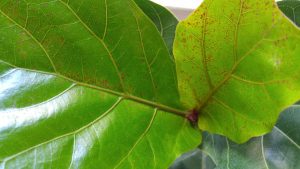
I recently bought a young fiddle leaf fig and it grew two new leaves but both have lots of red spots on them.
It is placed in a north-facing window.
Do you think it has too much light?
Is it too cold in this place?
Is it due to underwatering?
I had been waiting for the first inch of soil to become dry before watering but perhaps is this too long?
Does it require fertilizer?
Thank you for your help.
Thank you for contacting the Toronto Master Gardeners with your inquiry concerning your Ficus lyrata. From my research, it appears that the red spots appears to be a common problem with this tye of Ficus and is caused by underwatering or inconsistant watering. Fiddle-leafed Fig prefer bright, filtered light with consistent moisture. Water your plant as soon as the surface feels almost, but not quite dry. Add enough water so that a small amount trickles through the drain holes of the pot, but don’t allow it to sit in water or it will drop leaves and suffer from root rot.
The link Ficus Production Guide gives the following information on this physiological problem:
Symptoms – Small reddish spots, 1-3mm across, on the undersides of leaves of F. lyrata. The symptom is usually observed on stock plants in full sun which have been air layered, and most frequently during the driest months of December through June. This condition is rare on plants grown in shade. Leaves on wilted layers or cuttings of F. elastica, and possibly some other species, remain in relaxed orientation after normal moisture content is restored. This is a permanent condition. Branches of trees in an active state of growth may bend under moisture stress, then partially recover, leaving a permanent kink or “dogleg” in the stem.
Control – Severe moisture stress can usually be avoided through good nursery practices. Leaf spotting can be prevented by timely irrigation of stock and use of the vertical slit technique of air layering versus the girdling procedure. Permanent petiole wilt and stem kinking can be avoided with adequate soil moisture and high humidity during propagation.
Prevention of excessive root development outside the container eliminates most of the shock that occurs when large segments of root are severed from plants because roots extend into soil below the pot. Use of plastic ground covers, drip irrigation and root pruning during production usually eliminates root pruning shock when plants are removed.
Growing Fiddle-Leaf Fig Plants Indoors states ” The plants are also susceptible to various leaf-spotting ( usually brown) and fungal diseases, which are typically caused by lack of air flow and too much moisture sitting on the leaves.” The above link is an excellent refernece which lists solutions for various fungal diseases and also list the most common pests you should look out for.
Good Luck.

